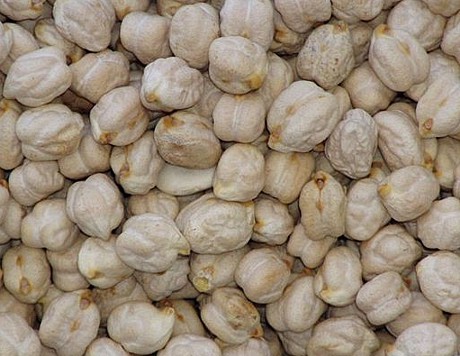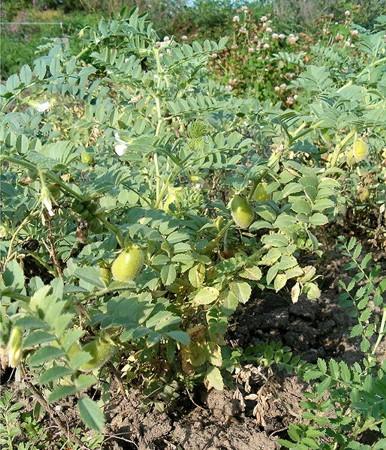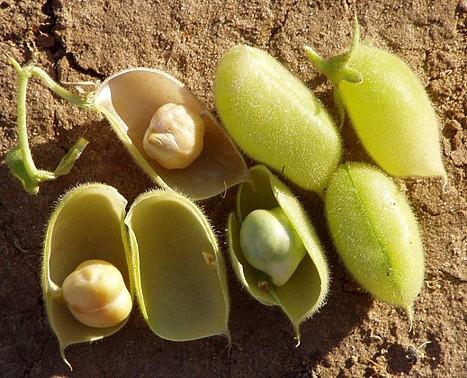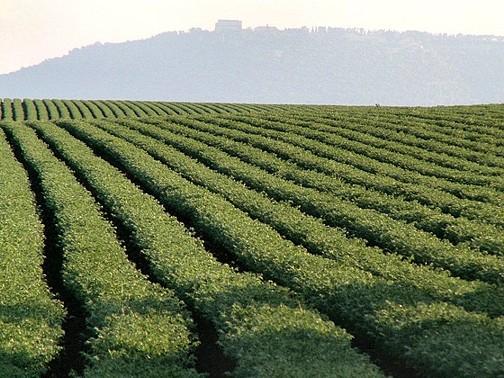Lessico
Cece
Cicer arietinum

Cicer
arietinum
Si noti la somiglianza dei semi con il profilo della testa di un ariete
Il cece (Cicer arietinum) è una pianta erbacea leguminosa della famiglia Fabaceae. I semi di questa pianta sono i ceci, legumi ampiamente usati nell'alimentazione umana che rappresentano un'ottima fonte proteica. La pianta presenta fusto peloso con altezza variabile tra 20 e 50 cm. Le foglie sono opposte, composte da foglioline dentate; i fiori sono solitari ascellari, bianchi, rosei o rossi; i semi, contenuti in numero di 2-3 nei baccelli, sono commestibili. Le radici della pianta possono penetrare nel terreno fino a 2 metri, e questo le consente di sopravvivere con pochissima acqua.
Il nome
deriva dal latino cicer che, a sua volta, trae forse origine
dall'antico greco macedone κίκερροι, kíkerroi = pallidi, giallastri. In
greco il cece era detto ἐρέβινθος, erébinthos, un termine al quale Aristofane![]() nelle Rane
attribuisce il significato traslato di membro virile, così come accade per
l'italiano pisello
nelle Rane
attribuisce il significato traslato di membro virile, così come accade per
l'italiano pisello![]() .
È noto
che il cognome di Cicerone
.
È noto
che il cognome di Cicerone![]() discendeva da un suo antenato che aveva una
caratteristica verruca a forma di cece sul naso. Il nome specifico arietinum
si riferisce invece alla somiglianza che hanno i semi con il profilo della
testa di un ariete.
discendeva da un suo antenato che aveva una
caratteristica verruca a forma di cece sul naso. Il nome specifico arietinum
si riferisce invece alla somiglianza che hanno i semi con il profilo della
testa di un ariete.

Il cece coltivato deriva da forme selvatiche del genere Cicer, probabilmente da Cicer reticulatum. Le specie selvatiche si sono originate probabilmente in Turchia, mentre le prime testimonianze archeologiche della coltivazione del cece risalgono all'età del bronzo e sono state rinvenute in Iraq. I ceci si diffusero in tutto il mondo antico: antico Egitto, Grecia antica, Impero romano.
I ceci sono tra i legumi più coltivati al mondo. Il cece è la terza leguminosa per produzione mondiale, dopo la soia e il fagiolo; la coltivazione avviene principalmente in India e Pakistan. In Italia la coltivazione non è molto diffusa a causa delle basse rese e della scarsa richiesta. Viene consumato principalmente nelle regioni meridionali insieme con la pasta e in Liguria, dove piatti tipici a base di ceci sono la farinata e la panissa.

Baccelli e semi
Tra i funghi che colpiscono il cece vi sono l'antracnosi (Ascochyta rabiei), la ruggine (Uromyces ciceris arietini) e il marciume carbonioso (Macrophomina phaseolina). Gli insetti maggiormente dannosi sono il tonchio dei ceci (Callosobruchus ornatus) e la mosca minatrice del pisello (Phytomiza atricornis).

The chickpea (Cicer arietinum) (also garbanzo bean, Indian pea, ceci bean, bengal gram, Kabuli chana, konda kadalai, kadale kaalu, sanaga pappu, shimbra, Kadala) is an edible legume of the family Fabaceae, subfamily Faboideae. Chickpeas are high in protein and one of the earliest cultivated vegetables. 7,500-year-old remains have been found in the Middle East.
The name chickpea traces
back through the French chiche to Latin cicer (from which the Roman
cognomen Cicero![]() was taken). The Oxford English Dictionary lists a 1548
citation that reads, "Cicer may be named in English Cich, or ciche pease,
after the Frenche tonge." The dictionary cites "Chick-pea" in
the mid-18th century; the original word in English was chich, found in print
in English in 1388, and taken directly from French.
was taken). The Oxford English Dictionary lists a 1548
citation that reads, "Cicer may be named in English Cich, or ciche pease,
after the Frenche tonge." The dictionary cites "Chick-pea" in
the mid-18th century; the original word in English was chich, found in print
in English in 1388, and taken directly from French.
The word garbanzo came to English as "calavance" in the 17th century, from Old Spanish (perhaps influenced by Old Spanish garroba or algarroba). The Portuguese arvançu has suggested to some that the origin of the word "Garbanzo" is in the Greek erebinthos. But the Oxford English Dictionary notes that some scholars doubt this; it also mentions a possible origination in the word garbantzu, from Basque — a non-Indo-European tongue — in which it is a compound of garau, seed + antzu, dry.
Domesticated chickpeas have been found in the aceramic levels of Jericho (PPNB) along with Cayönü in Turkey and in Neolithic pottery at Hacilar, Turkey. They are found in the late Neolithic (about 3500 BCE) at Thessaly, Kastanas, Lerna and Dimini. In southern France Mesolithic layers in a cave at L'Abeurador, Aude have yielded wild chickpeas carbon dated to 6790±90 BCE.
By the Bronze Age chickpeas were known in Italy and Greece. In classical Greece they were called erébinthos and eaten as a staple, a dessert or consumed raw when young. The Romans knew several varieties such as venus, ram and punic chickpeas. They were both cooked down into a broth and roasted as a snack. The Roman gourmet Apicius gives several recipes for chickpeas. Carbonized chickpeas have been found at the Roman legion fort at Neuss (Novaesium), Germany in layers from the 1st century CE, along with rice.
Chickpeas are mentioned in Charlemagne's Capitulare de villis (about 800 CE) as cicer italicum, as grown in each imperial demesne. Albertus Magnus mentions red, white and black varieties. Culpeper noted "chick-pease or cicers" are less "windy" than peas and more nourishing. Ancient people also associated chickpeas with Venus because they were said to offer medical uses such as increasing sperm and milk, provoking menstruation and urine and helping to treat kidney stones. Wild cicers were thought to be especially strong and helpful. In 1793 ground roast chickpeas were noted by a German writer as a coffee substitute in Europe and in the First World War they were grown for this in some areas of Germany. Chickpeas are still sometimes brewed instead of coffee.
The plant grows to between 20 and 50 cm high and has small feathery leaves on either side of the stem. One seedpod contains two or three peas. It has white flowers with blue, violet or pink veins. Chickpeas need a subtropical or tropical climate with more than 400 millimetres (16 in) of annual rain. They can be grown in a temperate climate but yields will be much lower.
There are two main kinds of chickpea: Desi, which has small, darker seeds and a rough coat, cultivated mostly in the Indian subcontinent, Ethiopia, Mexico, and Iran. Kabuli, which has lighter coloured, larger seeds and a smoother coat, mainly grown in Southern Europe, Northern Africa, Afghanistan, and Chile, also introduced during the 18th century to the Indian subcontinent.
The Desi (meaning country or local in Hindi) is also known as Bengal gram or kala chana. Kabuli (meaning from Kabul in Hindi, since they were thought to have come from Afghanistan when first seen in India) is the kind widely grown throughout the Mediterranean. Desi is likely the earliest form since it closely resembles seeds found both on archaeological sites and the wild plant ancestor of domesticated chickpeas (Cicer reticulatum) which only grows in southeast Turkey, where it is believed to have originated. Desi chickpeas have a markedly higher fiber content than Kabulis and hence a very low glycemic index which may make them suitable for people with blood sugar problems. The desi type is used to make Chana Dal, which is a split chickpea with the skin removed.
Chickpeas are grown in the Mediterranean, western Asia, the Indian subcontinent and Australia. Domestically they can be sprouted within a few days all year round with a sprouter on a windowsill. Mature chickpeas can be cooked and eaten cold in salads, cooked in stews, ground into a flour called gram flour (also known as besan and used primarily in Indian cuisine), ground and shaped in balls and fried as falafel, fermented to make an alcoholic drink similar to sake, stirred into a batter and baked to make farinata, cooked and ground into a paste called hummus or roasted, spiced and eaten as a snack (such as leblebi). Chick peas and bengal grams are used to make curries and are one of the most popular vegetarian foods in India, Pakistan, Bangladesh and the UK. On the Indian subcontinent chickpeas are called kadale kaalu in Kannada, shanaga in Telugu, chana in Hindi and other Indic languages, Chhola in Bengali and konda kadalai in Tamil, where they are a major source of protein in a mostly vegetarian culture.
Many popular dishes in Indian cuisine are made with chickpea flour, such as mirchi bajji and mirapakaya bajji telugu. In India, as well as in the Levant, unripe chickpeas are often picked out of the pod and eaten as a raw snack and the leaves are eaten as a green vegetable in salads. Chickpea flour is also used to make "Burmese tofu" which was first known among the Shan people of Burma. The flour is used as a batter to coat various vegetables and meats before frying, such as with panelle, a chickpea fritter from Sicily. Chickpea flour is also used to make the mediterranean flatbread socca. In the Philippines garbanzo beans preserved in syrup are eaten as sweets and in desserts such as halo-halo. Ashkenazi Jews traditionally serve whole chickpeas at a Shalom Zachar celebration for baby boys.
Dried chickpeas need a long cooking time (1–2 hours) but will not easily fall apart when cooked longer. If soaked for 12–24 hours before use, cooking time can be considerably shortened by 30 minutes. Raw chickpeas contain protease (enzyme that breaks down proteins) inhibitors which counteract the enzymes in our body that digest protein.
Chickpea output in 2005.India is the world leader in chickpea (bengal gram) production followed by Pakistan and Turkey. Chickpeas are a helpful source of zinc, folate and protein. They are also very high in dietary fiber and hence a healthy source of carbohydrates for persons with insulin sensitivity or diabetes. Chickpeas are low in fat and most of this is polyunsaturated. One hundred grams of mature boiled chickpeas contains 164 calories, 2.6 grams of fat (of which only 0.27 grams is saturated), 7.6 grams of dietary fiber and 8.9 grams of protein. Chickpeas also provide dietary calcium (49–53 mg/100 g), with some sources citing the garbanzo's calcium content as about the same as yogurt and close to milk. According to the International Crops Research Institute for the Semi-Arid Tropics chickpea seeds contain on average:
23% protein
64% total carbohydrates (47% starch, 6% soluble sugar)
5% fat
6% crude fiber
3% ash
There is also a high reported mineral content:
phosphorus (340 mg/100 g)
calcium (190 mg/100 g)
magnesium (140 mg/100g)
iron (7 mg/100 g)
zinc (3 mg/100 g)
Recent studies by government agencies have also shown that they can assist in lowering of cholesterol in the bloodstream.